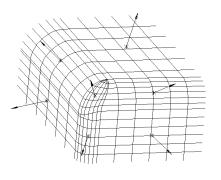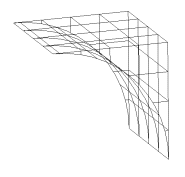Topology Checks
Neighboring bounded surfaces, which together form a particular part or a complete surface of an object, are called composite surfaces, surface groups, or topology. Within a topology, special requirements apply regarding the faces in the boundary curves.
When you click the Topology tab in the Geometry CHECK (VDA standard) dialog box, a tabbed page appears. It contains the following checks:
• Junction or Number of Faces per Edge (default check setting: < 3)—GeomIntegrityCHECK checks for topological consistency (that is, the explicitness and the unity of surface groups) and absence of junctions. It reports the location of multiple junctions.
GeomIntegrityCHECK locates the absence of junctions by examining the boundary curves of individual faces. A boundary curve may have in a section only one other boundary curve that is completely or partially congruent.
It is important for the topological explicitness of a surface that every inner face edge must have one explicit neighboring face. That is, every inner face cannot have more than one neighboring edge and must be free from bifurcation and junctions. It is however permissible that a face edge borders on several neighboring face edges, one after the other (T-type butt joint).
Recommended solution:
Remove superfluous faces.
• Orientation of Similar Normals—GeomIntegrityCHECK checks whether all the normals of neighboring faces in a group have the same orientation. It reports the faces with normals whose orientation differs from the orientation of the majority of normals in the same face.
If the definition of the topology element allows the presetting of a particular direction or orientation, this check ascertains whether all the normals comply with the preset orientation or not.
In the case of closed or unified groups, align all normals to the outside (away from the material) or to the inside (toward the material). In the case of open groups, reversal of the minority with a non-compliant orientation is optional.
The orientation of face normals within a topology must be uniform for the determination of the machining direction by milling. The same condition is necessary for hatched depictions and for ascertaining through the geometry the capability for ejecting the part from the tool, or for the definition of the touch direction by measuring.
Recommended solution:
Reverse individual face normals so that all face normals are topologically uniformly oriented away from the material.
• Knife Edge (default check setting: > 2)—GeomIntegrityCHECK reports the faces of composite surfaces whose angle between the tangential planes on a common boundary curve (or parts thereof) shows properties of a minute angle of nearly 0 degrees. At the restart points and fulcrums, GeomIntegrityCHECK calculates the angle between the tangential planes. GeomIntegrityCHECK reports all angles that are around 0 degrees.
If the angle of the tangential planes between neighboring bounded surfaces on the common edge is too small, sharp edges or recesses occur. Such areas cannot be produced. For example, they occur as a result of the subtraction of a cylinder from a cube.
After you have determined all the settings for the Topology checks, click OK to start the checking process, or click Cancel to specify new settings.


